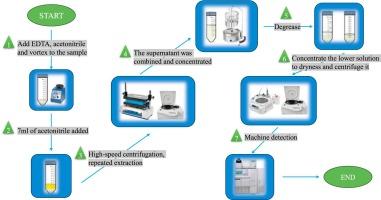Simultaneous determination of florfenicol, its metabolite and three fluoroquinolone residues in poultry muscles via high-performance liquid chromatography with fluorescence detection
IF 4.9
2区 化学
Q1 CHEMISTRY, ANALYTICAL
引用次数: 0
Abstract
A high-performance liquid chromatography with fluorescence detection (HPLC–FLD) procedure was developed and refined to detect florfenicol (FF), its metabolite florfenicol amine (FFA), and three fluoroquinolone (FQ) residues present in poultry muscles concurrently. Sample pretreatment was conducted through liquid–liquid extraction (LLE). Ethylenediaminetetraacetic acid (EDTA), 90 % acetonitrile and acetonitrile were used as extraction solvents. The stationary phase employed was an XBridge BEH C18 column (5 μm, 4.6 mm × 150 mm), and the mobile phase consisted of a 0.01 mol/L solution of sodium dihydrogen phosphate and acetonitrile (65:35, V/V); the former contained 0.005 mol/L sodium dodecyl sulfate and 0.1 % triethylamine (pH adjusted to 4.8 with phosphoric acid). The limits of detection (LODs) and limits of quantification (LOQs) were 0.03–1.5 µg/kg and 0.1–5.0 μg/kg, respectively. The linear relationships were satisfactory within the corresponding concentration ranges, with determination coefficients (R2) ≥ 0.9997. The mean recoveries ranged from 70.34 to 94.98 %, and the intraday relative standard deviations (RSDs) and interday RSDs were 1.46–6.24 % and 1.60–7.31 %, respectively. This verified method is applicable and reliable for analyzing actual samples.

通过高效液相色谱-荧光检测法同时测定家禽肌肉中的氟苯尼考、其代谢物和三种氟喹诺酮类药物残留量
开发并改进了一种高效液相色谱-荧光检测(HPLC-FLD)程序,用于同时检测家禽肌肉中的氟苯尼考(FF)、其代谢物氟苯尼考胺(FFA)和三种氟喹诺酮类药物(FQ)残留。样品预处理采用液液萃取法(LLE)。萃取溶剂为乙二胺四乙酸(EDTA)、90%乙腈和乙腈。固定相为 XBridge BEH C18 色谱柱(5 μm,4.6 mm × 150 mm),流动相为 0.01 mol/L 磷酸二氢钠和乙腈溶液(65:35,V/V);前者含有 0.005 mol/L 十二烷基硫酸钠和 0.1 % 三乙胺(pH 值用磷酸调至 4.8)。检出限(LOD)和定量限(LOQ)分别为 0.03-1.5 µg/kg 和 0.1-5.0 μg/kg。在相应的浓度范围内线性关系良好,测定系数 (R2) ≥ 0.9997。平均回收率为70.34%~94.98%,日内相对标准偏差为1.46%~6.24%,日间相对标准偏差为1.60%~7.31%。该验证方法适用于实际样品的分析,结果可靠。
本文章由计算机程序翻译,如有差异,请以英文原文为准。
求助全文
约1分钟内获得全文
求助全文
来源期刊

Microchemical Journal
化学-分析化学
CiteScore
8.70
自引率
8.30%
发文量
1131
审稿时长
1.9 months
期刊介绍:
The Microchemical Journal is a peer reviewed journal devoted to all aspects and phases of analytical chemistry and chemical analysis. The Microchemical Journal publishes articles which are at the forefront of modern analytical chemistry and cover innovations in the techniques to the finest possible limits. This includes fundamental aspects, instrumentation, new developments, innovative and novel methods and applications including environmental and clinical field.
Traditional classical analytical methods such as spectrophotometry and titrimetry as well as established instrumentation methods such as flame and graphite furnace atomic absorption spectrometry, gas chromatography, and modified glassy or carbon electrode electrochemical methods will be considered, provided they show significant improvements and novelty compared to the established methods.
 求助内容:
求助内容: 应助结果提醒方式:
应助结果提醒方式:


